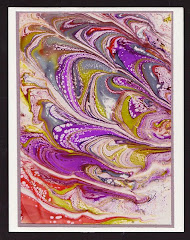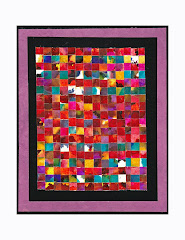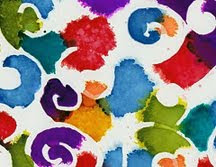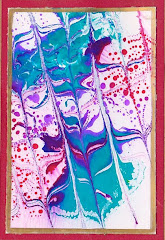I have been experimenting with several tools for making resist designs. When I was in first grade I remember using crayons to make a design, and then painting with water colors over it to allow the initial design, the resist to show through. I thought it was practically magic, and I think that's when I fell in love with making resists. I was really excited to learn about "grown up" ways to utilize this technique in my current projects.
 About a year ago, I was reading through a stack of recent issues of Cloth☉Paper☉Scissors, one of my favorite ways to search for inspiration. Cloth☉Paper☉Scissors, is an amazing arts magazine published 6 times a year that focuses on "collage, mixed media and artistic discovery" (see below for some contact info). Since I was struggling with a lack of inspiration, I felt I just needed a jumping off point. I came across an article (or possibly an editorial) about letting go, and reaching for tools unfamiliar to us as artists. The article said to let my imagination go wild — layer different media, use different tools, rummage through your junk drawer for ideas and inspiration! I looked everywhere and could find nothing -- not a crayon, not a fancy art marker -- nada. Out of the corner of my eye, as I rummaged in the bottom of a drawer, I saw a piece of something that looked promising. It was a little like a crayon in size and shape, but was nearly colorless like a white candle. Upon closer inspection, I discovered that it was a piece of a colorless solid lubricant, in stick form, used for lubricating stuck or stubborn zippers, sticky windows and squeaky drawers. The lubricant is called Ezy-Zipper Glide (see below for contact information) and turns out to be a really great item for making wonderful resists. It is harder than a crayon, and is shaped like one with a point when you take it out of the package. Be aware that it is also breakable like a crayon, too. It makes a firm colorless mark, and for a fine point you can sharpen it with a good quality sharpener.
About a year ago, I was reading through a stack of recent issues of Cloth☉Paper☉Scissors, one of my favorite ways to search for inspiration. Cloth☉Paper☉Scissors, is an amazing arts magazine published 6 times a year that focuses on "collage, mixed media and artistic discovery" (see below for some contact info). Since I was struggling with a lack of inspiration, I felt I just needed a jumping off point. I came across an article (or possibly an editorial) about letting go, and reaching for tools unfamiliar to us as artists. The article said to let my imagination go wild — layer different media, use different tools, rummage through your junk drawer for ideas and inspiration! I looked everywhere and could find nothing -- not a crayon, not a fancy art marker -- nada. Out of the corner of my eye, as I rummaged in the bottom of a drawer, I saw a piece of something that looked promising. It was a little like a crayon in size and shape, but was nearly colorless like a white candle. Upon closer inspection, I discovered that it was a piece of a colorless solid lubricant, in stick form, used for lubricating stuck or stubborn zippers, sticky windows and squeaky drawers. The lubricant is called Ezy-Zipper Glide (see below for contact information) and turns out to be a really great item for making wonderful resists. It is harder than a crayon, and is shaped like one with a point when you take it out of the package. Be aware that it is also breakable like a crayon, too. It makes a firm colorless mark, and for a fine point you can sharpen it with a good quality sharpener. In the piece featured in this post (see above), most of the white space was where I drew with this lubricant, and the colored space is from Copic re-inkers where drop by drop I allowed the ink to bleed, creep, and merge. Copic inks are alcohol inks distributed by Imagination International, Inc. of Eugene, Oregon (see below for contact information).
Of course you can use crayons for making resists. But if you want to learn about a number of creative and great methods for making resists, please look below for a great book that showcases some great resist techniques. In the next post we will continue to discuss a few of the exciting and fun techniques I've tried in my own work.
RESOURCES:
Ezy-Zipper Glide by Prym-Dritz Corporation
www.dritz.com
Copic Refillable Inks (re-inkers)
www.copicmarker.com
1-866-662-6742
Cloth Paper Scissors
www.clothpaperscissors.com
BOOK:
Journal Spilling by Diana Trout, 1st Ed.
Copyright © 2009
Thanks, guys!! Watch for From the Humble Crayon - Exciting Techniques for making Resists(part 2), coming soon. MEANWHILE: Do *you* have a favorite resist technique that you like? Is there something you want to say about the resources or book I've mentioned above? I'm eager to hear what you think!









